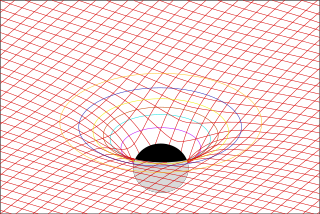A centripetal force is a force that makes a body follow a curved path. Its direction is always orthogonal to the motion of the body and towards the fixed point of the instantaneous center of curvature of the path. Isaac Newton described it as "a force by which bodies are drawn or impelled, or in any way tend, towards a point as to a centre". In Newtonian mechanics, gravity provides the centripetal force causing astronomical orbits.
In mathematics, the Laplace transform, named after its inventor Pierre-Simon Laplace, is an integral transform that converts a function of a real variable to a function of a complex variable . The transform has many applications in science and engineering because it is a tool for solving differential equations. In particular, it transforms linear differential equations into algebraic equations and convolution into multiplication.
In vector calculus and differential geometry the generalized Stokes theorem, also called the Stokes–Cartan theorem, is a statement about the integration of differential forms on manifolds, which both simplifies and generalizes several theorems from vector calculus. It is a generalization of Isaac Newton's fundamental theorem of calculus that relates two-dimensional line integrals to three-dimensional surface integrals.
Fractional calculus is a branch of mathematical analysis that studies the several different possibilities of defining real number powers or complex number powers of the differentiation operator D
In physics, Liouville's theorem, named after the French mathematician Joseph Liouville, is a key theorem in classical statistical and Hamiltonian mechanics. It asserts that the phase-space distribution function is constant along the trajectories of the system—that is that the density of system points in the vicinity of a given system point traveling through phase-space is constant with time. This time-independent density is in statistical mechanics known as the classical a priori probability.

The path integral formulation is a description in quantum mechanics that generalizes the action principle of classical mechanics. It replaces the classical notion of a single, unique classical trajectory for a system with a sum, or functional integral, over an infinity of quantum-mechanically possible trajectories to compute a quantum amplitude.

In relativity, proper time along a timelike world line is defined as the time as measured by a clock following that line. It is thus independent of coordinates, and is a Lorentz scalar. The proper time interval between two events on a world line is the change in proper time. This interval is the quantity of interest, since proper time itself is fixed only up to an arbitrary additive constant, namely the setting of the clock at some event along the world line.
In physics, the Hamilton–Jacobi equation, named after William Rowan Hamilton and Carl Gustav Jacob Jacobi, is an alternative formulation of classical mechanics, equivalent to other formulations such as Newton's laws of motion, Lagrangian mechanics and Hamiltonian mechanics. The Hamilton–Jacobi equation is particularly useful in identifying conserved quantities for mechanical systems, which may be possible even when the mechanical problem itself cannot be solved completely.
In differential geometry, the four-gradient is the four-vector analogue of the gradient from vector calculus.
In general relativity, the Gibbons–Hawking–York boundary term is a term that needs to be added to the Einstein–Hilbert action when the underlying spacetime manifold has a boundary.
In calculus, the Leibniz integral rule for differentiation under the integral sign, named after Gottfried Leibniz, states that for an integral of the form

A theoretical motivation for general relativity, including the motivation for the geodesic equation and the Einstein field equation, can be obtained from special relativity by examining the dynamics of particles in circular orbits about the earth. A key advantage in examining circular orbits is that it is possible to know the solution of the Einstein Field Equation a priori. This provides a means to inform and verify the formalism.

In physics, Maxwell's equations in curved spacetime govern the dynamics of the electromagnetic field in curved spacetime or where one uses an arbitrary coordinate system. These equations can be viewed as a generalization of the vacuum Maxwell's equations which are normally formulated in the local coordinates of flat spacetime. But because general relativity dictates that the presence of electromagnetic fields induce curvature in spacetime, Maxwell's equations in flat spacetime should be viewed as a convenient approximation.

In probability theory and statistics, the skew normal distribution is a continuous probability distribution that generalises the normal distribution to allow for non-zero skewness.
The fundamental theorem of calculus is a theorem that links the concept of differentiating a function with the concept of integrating a function. The two operations are inverses of each other apart from a constant value which is dependent on where one starts to compute area.
In continuum mechanics, a compatible deformation tensor field in a body is that unique tensor field that is obtained when the body is subjected to a continuous, single-valued, displacement field. Compatibility is the study of the conditions under which such a displacement field can be guaranteed. Compatibility conditions are particular cases of integrability conditions and were first derived for linear elasticity by Barré de Saint-Venant in 1864 and proved rigorously by Beltrami in 1886.

The vibration of plates is a special case of the more general problem of mechanical vibrations. The equations governing the motion of plates are simpler than those for general three-dimensional objects because one of the dimensions of a plate is much smaller than the other two. This suggests that a two-dimensional plate theory will give an excellent approximation to the actual three-dimensional motion of a plate-like object, and indeed that is found to be true.
Vasiliev equations are formally consistent gauge invariant nonlinear equations whose linearization over a specific vacuum solution describes free massless higher-spin fields on anti-de Sitter space. The Vasiliev equations are classical equations and no Lagrangian is known that starts from canonical two-derivative Frønsdal Lagrangian and is completed by interactions terms. There is a number of variations of Vasiliev equations that work in three, four and arbitrary number of space-time dimensions. Vasiliev's equations admit supersymmetric extensions with any number of super-symmetries and allow for Yang-Mills gaugings. Vasiliev's equations are background independent, the simplest exact solution being anti-de Sitter space. It is important to note that locality is not properly implemented and the equations give a solution of certain formal deformation procedure, which is difficult to map to field theory language. The higher-spin AdS/CFT correspondence is reviewed in Higher-spin theory article.
In mathematics, Katugampola fractional operators are integral operators that generalize the Riemann–Liouville and the Hadamard fractional operators into a unique form. The Katugampola fractional integral generalizes both the Riemann–Liouville fractional integral and the Hadamard fractional integral into a single form and It is also closely related to the Erdelyi–Kober operator that generalizes the Riemann–Liouville fractional integral. Katugampola fractional derivative has been defined using the Katugampola fractional integral and as with any other fractional differential operator, it also extends the possibility of taking real number powers or complex number powers of the integral and differential operators.
In mathematics, differential forms on a Riemann surface are an important special case of the general theory of differential forms on smooth manifolds, distinguished by the fact that the conformal structure on the Riemann surface intrinsically defines a Hodge star operator on 1-forms without specifying a Riemannian metric. This allows the use of Hilbert space techniques for studying function theory on the Riemann surface and in particular for the construction of harmonic and holomorphic differentials with prescribed singularities. These methods were first used by Hilbert (1909) in his variational approach to the Dirichlet principle, making rigorous the arguments proposed by Riemann. Later Weyl (1940) found a direct approach using his method of orthogonal projection, a precursor of the modern theory of elliptic differential operators and Sobolev spaces. These techniques were originally applied to prove the uniformization theorem and its generalization to planar Riemann surfaces. Later they supplied the analytic foundations for the harmonic integrals of Hodge (1940). This article covers general results on differential forms on a Riemann surface that do not rely on any choice of Riemannian structure.






















